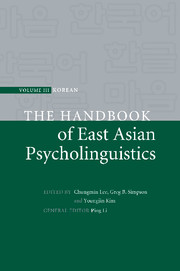Book contents
- Frontmatter
- Contents
- List of figures
- List of tables
- List of contributors
- Preface
- Introduction: Advances in Korean psycholinguistics
- Part I Language acquisition
- 1 Acquisition of the subject and topic nominals and markers in the spontaneous speech of young children in Korean
- 2 The acquisition of argument structure and transitivity in Korean: a discourse-functional approach
- 3 Acquisition of case markers and grammatical functions
- 4 Do Korean children acquire verbs earlier than nouns?
- 5 The acquisition of the placement of the verb in the clause structure of Korean
- 6 Learning locative verb syntax: a crosslinguistic experimental study
- 7 Language-specific spatial semantics and cognition: developmental patterns in English and Korean
- 8 Acquisition of negation in Korean
- 9 The acquisition of Korean numeral classifiers
- 10 Acquisition of Korean reflexive anaphora
- 11 The Korean relative clause: issues of processing and acquisition
- 12 The accessibility hierarchy in Korean: head-external and head-internal relative clauses
- 13 Development of functional categories in child Korean
- 14 The acquisition of modality
- 15 The syntax of overmarking and kes in child Korean
- 16 Events in passive development
- 17 Universal quantification in child grammar
- 18 Acquisition of prosody in Korean
- 19 Korean as a heritage language
- 20 Maturational effects on L2 acquisition
- 21 L2 acquisition of English articles by Korean speakers
- 22 The acquisition of wanna contraction by adult Korean learners of English
- 23 Phonological abilities of Korean–English bilinguals
- 24 Parameters on languages in contact: an altered view of codeswitching
- 25 Influence of socio-psychological categories in bilingual interaction
- 26 Ontological concept versus shape in word learning from a crosslinguistic point of view
- 27 Notes on Korean Sign Language
- Part II Language processing
- References
- Name index
- Subject index
23 - Phonological abilities of Korean–English bilinguals
from Part I - Language acquisition
Published online by Cambridge University Press: 05 June 2012
- Frontmatter
- Contents
- List of figures
- List of tables
- List of contributors
- Preface
- Introduction: Advances in Korean psycholinguistics
- Part I Language acquisition
- 1 Acquisition of the subject and topic nominals and markers in the spontaneous speech of young children in Korean
- 2 The acquisition of argument structure and transitivity in Korean: a discourse-functional approach
- 3 Acquisition of case markers and grammatical functions
- 4 Do Korean children acquire verbs earlier than nouns?
- 5 The acquisition of the placement of the verb in the clause structure of Korean
- 6 Learning locative verb syntax: a crosslinguistic experimental study
- 7 Language-specific spatial semantics and cognition: developmental patterns in English and Korean
- 8 Acquisition of negation in Korean
- 9 The acquisition of Korean numeral classifiers
- 10 Acquisition of Korean reflexive anaphora
- 11 The Korean relative clause: issues of processing and acquisition
- 12 The accessibility hierarchy in Korean: head-external and head-internal relative clauses
- 13 Development of functional categories in child Korean
- 14 The acquisition of modality
- 15 The syntax of overmarking and kes in child Korean
- 16 Events in passive development
- 17 Universal quantification in child grammar
- 18 Acquisition of prosody in Korean
- 19 Korean as a heritage language
- 20 Maturational effects on L2 acquisition
- 21 L2 acquisition of English articles by Korean speakers
- 22 The acquisition of wanna contraction by adult Korean learners of English
- 23 Phonological abilities of Korean–English bilinguals
- 24 Parameters on languages in contact: an altered view of codeswitching
- 25 Influence of socio-psychological categories in bilingual interaction
- 26 Ontological concept versus shape in word learning from a crosslinguistic point of view
- 27 Notes on Korean Sign Language
- Part II Language processing
- References
- Name index
- Subject index
Summary
Introduction
The information reviewed in this paper is about Korean-English bilinguals; specifically it is about native Koreans who emigrated to the US at different ages. The findings to be reported are colored by the fact that at the time of testing for the main study the participants were long-term residents of the US living in communities in and around the Washington, DC area. The participants lived with their families and spoke Korean at home and Korean was their only language during their preschool years; however, the language environment outside their homes was predominantly English. In studying bilingualism and evaluating the achievement of bilingual individuals it is important to recognize the linguistic make-up of the country of residence. Studies carried out in other linguistic environments may very well produce different results from those reported here.
Theories of first (L1) and second (L2) language acquisition invariably get embroiled in the issue of the Critical or Sensitive Period Hypothesis (CPH). Advocates of the CPH use age of learning as the primary index of the individuals' neural maturational state and do not worry much about the effects of experiential factors that co-vary with age. The majority of studies of L2 pronunciation carried out in the US with immigrant populations show an age of learning effect that favors early L2 learners (Asher & Garcia, 1969; Fathman, 1975; Oyama, 1976; Tahta, Wood & Lowenthal, 1981b; Patkowski, 1990, 1994; Flege, Munro & MacKay, 1995; Flege, Yeni-Komshian & Liu, 1999; Yeni-Komshian, Flege & Liu, 2000; see also research reviewed by Scovel, 1988; Long, 1990; Harley & Wang, 1997, and Birdsong, 1999).
- Type
- Chapter
- Information
- The Handbook of East Asian Psycholinguistics , pp. 318 - 330Publisher: Cambridge University PressPrint publication year: 2009



